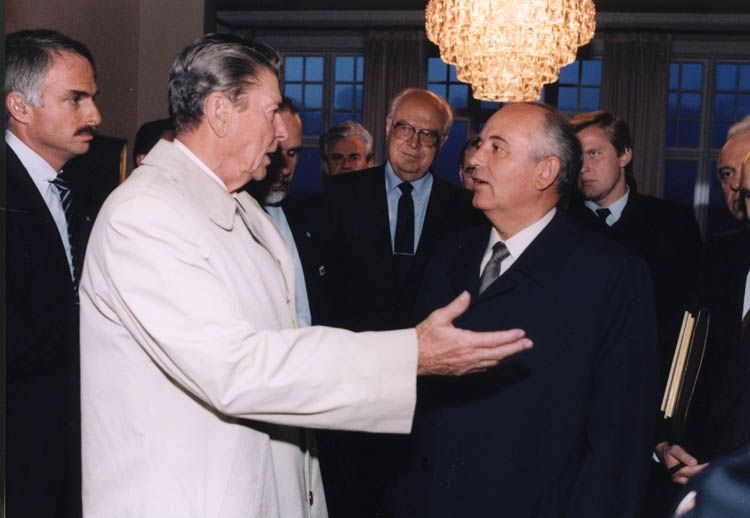Reagan’s optical illusions
By Hugh Gusterson | May 14, 2014

I’ve long been skeptical that much thinking gets done in conservative think tanks. A recent visit to the Heritage Foundation in downtown Washington DC did little to disabuse me of this notion.
The occasion for my visit was a talk by Kenneth Adelman to promote his new book, Reagan at Reykjavik. Adelman was Ronald Reagan’s director of the Agency for Arms Control and Disarmament, and he was present for the extraordinary 1986 summit in Iceland where the two superpower leaders, President Reagan and the Soviet Union’s Mikhail Gorbachev, came close to eliminating all their nuclear weapons.
I went to Adelman’s talk in the hope of understanding why an administration that had spent the previous six years smearing the Nuclear Freeze campaign as a communist conspiracy suddenly careened into abolitionism. Adelman’s talk was of no help in understanding that, but I did learn a lot about the way American conservatives look at masculinity, diplomatic negotiation, and image management.
What I found most extraordinary in Adelman’s 45-minute talk about a summit that almost led to the elimination of all Soviet and American nuclear weapons is that Adelman never once used the words “nuclear weapons;” nor did he explain why a president who had presided over a massive nuclear arms build-up suddenly wanted to eliminate the weapons he had been producing at a rate of four a day. I had hoped to find out what analyses by the administration’s arms control analysts preceded the summit, the reaction of the Departments of Energy and Defense to this sudden eruption of nuclear abolitionism, and the degree to which the two world leaders discussed the practical nuts and bolts of abolishing nuclear weapons. Adelman gave us none of that.
Instead he began with an extended discussion of still photos and a video clip of the first meeting between Reagan and Gorbachev at the previous summit in Geneva. The Heritage audience gave delighted guffaws as Adelman showed how Reagan positioned himself as the alpha male at that meeting by appearing coatless in the Swiss winter to greet Gorbachev, who was bundled in hat and coat, and by supporting Gorbachev’s arm as he climbed the steps as if the older man was in fact the more vigorous.
Adelman also showed a video clip of the 1987 Berlin speech in which Ronald Reagan famously said, “Mr. Gorbachev, tear down this wall.” He revealed that, up to the last minute, the president’s advisors had counselled against this line and against making it personal with Gorbachev by addressing such an injunction to him personally. Adelman laughed at Reagan’s chutzpah, and said, “It was like ‘up yours!’” The Heritage audience burst into laughter.
Adelman’s other big laugh line came when he mentioned that Gorbachev complained “11 or 12 times” during the summit that he was making all the concessions and Reagan was conceding nothing. In Adelman’s words, “Reagan said nothing, and I’m sure he was thinking, ‘What’s wrong with that?’” (To understand what’s wrong with that, see the Business Dictionary definition of negotiation: “Bargaining (give and take) process between two or more parties (each with its own aims, needs, and viewpoints) seeking to discover a common ground and reach an agreement to settle a matter of mutual concern or resolve a conflict.”)
Apart from that, Adelman showed some pictures of the cramped old house where the summit took place, Iceland’s prime minister holding a press conference in his swimming trunks, and a BBC video clip that dramatized Adelman advising Ronald Reagan inside “the bubble”—a steel chamber the Americans brought to Reykjavik inside which they could hold secure conversations. He finished with an excerpt from Reagan’s first inaugural address set to images of American weaponry and military funerals.
Adelman did give some credit to the Soviets. Curiously, he expressed admiration for Marshal Sergei F. Akhromeyev, a much-decorated hero of World War II who accompanied Gorbachev to Reykjavik in 1986. He spoke with sadness of Akhromeyev’s suicide in 1991 without noting that it followed his support for an attempted coup against Gorbachev, whose nuclear cuts he sometimes opposed.
He also expressed admiration for Raisa Gorbachev, observing that she changed outfits four times in one day at Reykjavik and wooed the Western media with her chic style. (At this point it bears noting that Adelman himself is quite a clotheshorse. On this occasion he looked dapper and effete—like the Tom Wolfe of public policy—in a contrast collar shirt, a bold floral tie, and a navy jacket with red breast pocket handkerchief).
At first I thought I had wasted my time by going to hear Adelman because he said nothing about nuclear weapons policy. But, on reflection, his talk was deeply revealing about the Reagan Administration’s nuclear weapons policy—precisely because Adelman said nothing about it. That policy was always less about nuclear strategy and the balance of forces than about making Reagan look good. The search for an arms control agreement at Geneva mattered less than Reagan’s visual domination of Gorbachev when they shook hands. Meanwhile the Reagan administration’s actual nuclear initiatives lurched in an alarmingly improvisational and almost hallucinatory fashion from one extreme to the other—from plans for winnable nuclear wars to talk of abolition—precisely because strategic thinking was not the orienting force. The administration that advanced the “zero option” on intermediate nuclear weapons because it would look good but be difficult for the Soviets to accept was always more concerned with the optics of negotiation than the practicalities. And, as Adelman’s biggest laugh line dramatized, negotiation was not a painstaking process aiming to find a resolution that would advance the interests of both nations, but a way of performing the subordination of others, an arena in which the United States could, modeling statecraft on cheap hucksterism, get something for nothing. As Adelman tacitly made clear in his talk, the point of the Reagan administration’s foreign policy was not to create a less dangerous configuration of nuclear weapons in the world but to perform American dominance, using foreign leaders as human props and cold war flashpoints as compelling backdrops.
If only this approach to foreign policy had gone to the grave with Ronald Reagan. Instead, it has metastasized. We see it in everything from George W. Bush’s 2003 “mission accomplished” photo-op speech, substituting Iraq War wish for reality aboard a US aircraft carrier, to conservative columnists’ taunting of President Obama for not being manly enough to stop Russian President Vladimir Putin from annexing Crimea. And we see it in congressional hearings on Benghazi, which treat a minor event in which four Americans sadly died as if it were a scandal on the scale of Watergate or the Iran-Contra Affair. As anyone who has recently attended a congressional hearing or a White House press conference knows, US politics are dominated by manufactured sound bites and visual posing. Substance matters less than appearance. Meanwhile we remain stuck in neutral on global warming and nuclear weapons, the great threats of our age. This too is Reagan’s legacy.
Together, we make the world safer.
The Bulletin elevates expert voices above the noise. But as an independent nonprofit organization, our operations depend on the support of readers like you. Help us continue to deliver quality journalism that holds leaders accountable. Your support of our work at any level is important. In return, we promise our coverage will be understandable, influential, vigilant, solution-oriented, and fair-minded. Together we can make a difference.
Topics: Columnists, Nuclear Weapons














